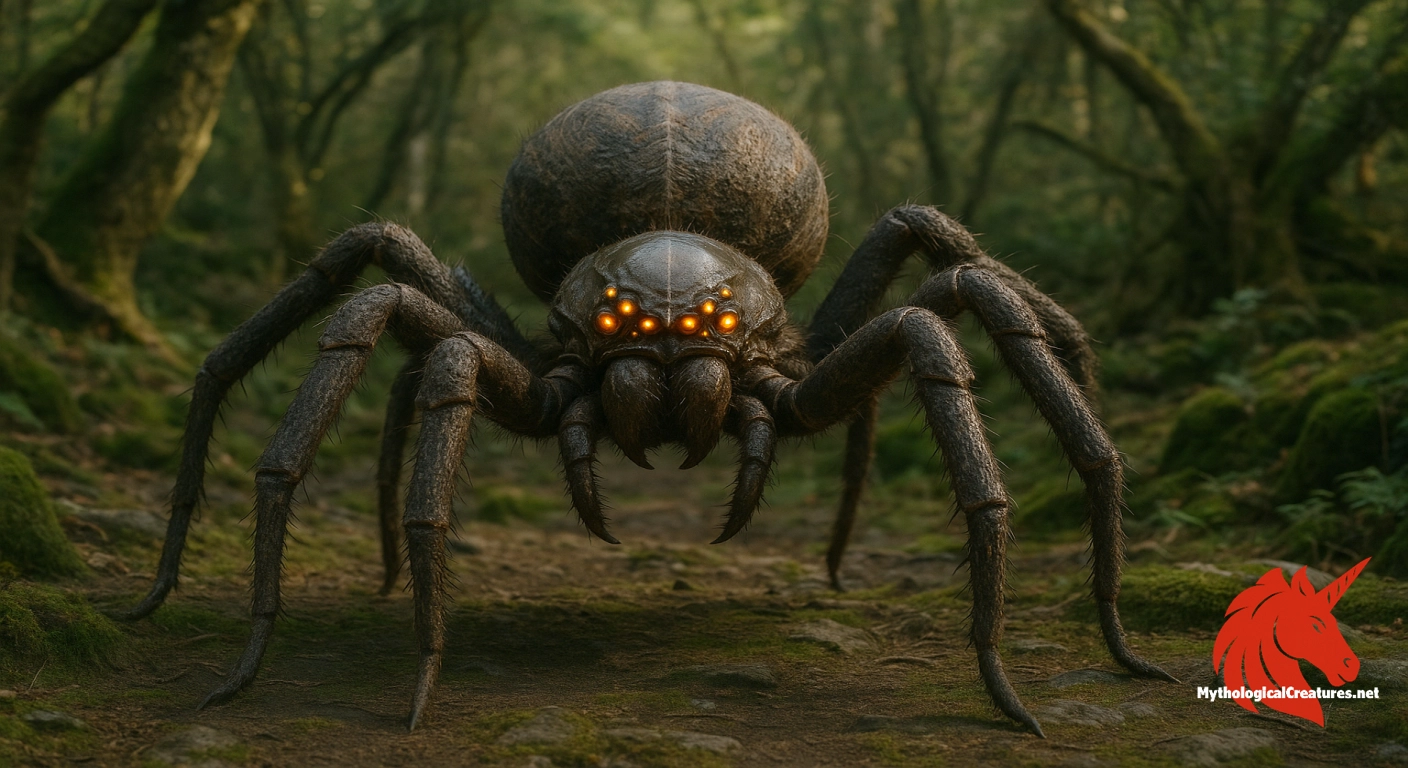Djieien: Djieien is a towering, monstrous spider from Seneca mythology renowned for its hidden heart that rendered it nearly invincible.

Djieien
Djieien - Djieien represents the theme that even the mightiest of beings possess a hidden vulnerability, serving as a cautionary emblem in Seneca mythology.
Origins & First Encounters
The legend of Djieien emerges from the rich tapestry of Seneca myth as a formidable entity whose story captivates both its community and later audiences. Djieien is depicted as a monstrous spider, towering at an imposing six feet tall, which immediately sets it apart as both awe-inspiring and fearsome. Its origin is deeply rooted in ancient oral traditions, passed down through generations of Seneca storytellers, where the creature embodies the mysterious forces of nature. The myth, first attested in heroic narratives involving figures such as Othegwenhda, highlights the eternal struggle between human resilience and supernatural might. Throughout its telling, the tale of Djieien focusses on the paradox of power and vulnerability, as the beast’s invulnerability rests on a hidden secret – its heart concealed within the earth. This narrative element has spurred imaginative interpretations that explore themes of concealed weaknesses and the triumph of courage. The cultural context within which Djieien is placed reflects a deep respect for the unpredictable natural world, and the story continues to serve as a moral and metaphoric guide. As a symbol of both danger and the hidden depths of nature, Djieien remains an enduring figure that bridges the realms of myth and reality. Its continued resonance underscores the timeless appeal of challenges that defy simple explanation.
Source Texts & Tale Variants
Ancient oral accounts preserve the vivid exploits of Djieien, a creature featured prominently in the epic tale of Hagowanen and Ot'hegwenhda. Narratives from the Seneca tradition recount dramatic encounters in which the monstrous spider appears as an almost invincible adversary, its only vulnerability lying in its concealed heart. Storytellers have transmitted these accounts over generations, ensuring that even minor variations in detail highlight different aspects of the myth. Some versions stress the cunning and agility of Djieien, while others focus on its sheer size and foreboding presence. Early transcriptions of these oral traditions, though limited, capture the essence of a being that is both physically formidable and mysteriously elusive. As the recounting of Djieien’s deeds spread among diverse Seneca communities, different storytellers began to adapt and embellish the narrative to suit their local contexts. These evolving variants illustrate not only a multiplicity of perspectives but also the adaptability of the myth in the face of changing cultural landscapes. Recorded ethnographic notes from later periods further attest to the persistence of Djieien’s legend, even as the medium of its telling shifted from spoken word to written form. The amalgamation of these sources confirms the creature’s status as a central figure in Seneca myth, whose story continues to intrigue both scholars and enthusiasts today.
Form & Powers
Djieien is envisioned as a colossal spider whose form merges both natural terror and uncanny supernatural attributes. Standing at an impressive six feet tall, its body is encased in a rough, chitinous exoskeleton that seems to shimmer under low light, imparting a sense of both resilience and mystery. Multiple eyes, each reflecting a predatory gleam, are set in a pattern that suggests an intelligence beyond mere instinct. The creature’s long, spindly legs, equipped with subtle, spine-like projections, convey an elegance that belies their lethal capacity. Intricate markings and patterns along its body hint at deeper symbolic meanings, as if each line were part of an ancient script. Artists and storytellers alike have imagined Djieien with an almost ethereal quality, blending the terrifying aspects of a natural predator with hints of the supernatural. The hidden location of its heart, buried deep beneath the soil, reinforces the idea that this creature harbours secrets that go beyond the physical realm. Every component of its anatomy, from the delicate articulation of its joints to the menacing arrangement of its fangs, contributes to a portrait of a being that is as enigmatic as it is formidable. The elaborate visual depiction of Djieien not only enhances its mythic stature but also captures the imagination of those who ponder the mysteries of its creation.
Regional Faces
In the diverse regions where Seneca traditions flourish, the tale of Djieien has taken on variations that reflect local landscapes and cultural nuances. Some communities have woven additional layers into the narrative, portraying Djieien as a bringer of natural imbalance or even as a guardian of sacred wild places. In regions where dense forests and winding streams dominate the scenery, storytellers often accentuate the creature’s association with the secretive forces of nature. Local adaptations may highlight differences in its appearance, such as variations in the patterns on its exoskeleton or the intensity of its predatory gaze. These subtle shifts in description allow the myth to resonate with the specific environmental and spiritual contexts of each community. In some telling, the spider’s hidden heart is endowed with mystical properties that link it directly to the land’s vitality or decay. The regional narratives underscore a broader cultural adaptability, where the core themes of invulnerability and hidden weakness remain intact while local colour is added through imaginative details. Such variations demonstrate how Djieien has successfully transcended a singular narrative, embodying traits that are reinterpreted with every retelling. This fluidity in the myth speaks to an enduring legacy that is continuously nurtured by the intersection of tradition and local belief systems.
Cultural Parallels
The motif of a monstrous creature harbouring a fatal secret unites Djieien with a range of mythological beings found throughout the world. Much like classical heroes who discover an inherent flaw in an otherwise indestructible foe, the narrative of Djieien mirrors universal themes of vulnerability hidden within strength. Comparable echoes can be found in legendary figures from diverse traditions, where the existence of a concealed weak spot is a recurring narrative device. The creature’s arachnid nature also draws subtle parallels with other mythic spiders that have been attributed roles as both creators and tricksters in various cultures. Across continents, similar stories have emerged in which enigmatic beings command both fear and respect, reflecting humanity’s obsession with the duality of power and fragility. This interplay is reminiscent of ancient tales where a divine or monstrous entity is undone by a single, overlooked sin or flaw. The universal fascination with hidden weaknesses – whether in the guise of a buried heart or an overlooked talisman – encourages cross-cultural conversations about the impermanence of strength. By examining these shared motifs, one gains insight into how different cultures use myth to explore the complexities of invulnerability and mortality. The enduring similarities serve as a reminder that regardless of cultural background, the exploration of a hero’s quest to uncover hidden truths is a timeless and unifying element of mythic storytelling.
Legacy & Modern Evolution
The figure of Djieien has evolved significantly from its early portrayal in Seneca oral tradition to become a powerful symbol in modern myth and art. What began as a stark tale of a seemingly invincible creature has been reimagined over time, reflecting both the changing attitudes towards nature and the evolution of cultural storytelling. Early depictions were grounded in the raw and untamed spirit of the natural world, emphasising brute physical presence and a mystical vulnerability encapsulated by the hidden heart. In the modern era, Djieien’s narrative has been infused with rich layers of metaphor, representing inner fears, environmental cautionary tales, and the interplay between strength and frailty. Contemporary indigenous artists and writers often reinterpret the monster, using its image to reflect broader themes of resurgence in cultural identity and the complexities of modern existence. The resurgence of interest in traditional mythologies has led to innovative adaptations in literature, film, and visual arts, where Djieien appears not only as a symbol of menace but also as an allegory for hidden truths within the human spirit. This dynamic evolution mirrors a wider shift in mythic narratives that seek to bridge the gap between ancestral wisdom and modern sensibilities. In recognising the continuing relevance of such myths, modern storytellers have ensured that Djieien remains a compelling figure whose legacy transcends time, bridging ancient tradition with contemporary cultural dialogue. The creature’s myth endures as both a cautionary emblem and a source of inspiration, inviting new generations to explore the enduring mysteries of life.
Interesting Fact
An intriguing aspect of Djieien's myth is its invincibility tied directly to a hidden heart, a motif that underscores the eternal theme of concealed weakness in seemingly invulnerable creatures.
Quick Creature Info
Origin:
Features:
Associations:
Our Mythic Legendary Rating:

Habitat:
Supernatural Powers:
Physical Attributes:
Abilities:
Behavior:
Weaknesses:
Lore:
Related Creatures, Tales or Lore
- TTsuchigumo
- AArachne
- AAnansi
References
Discover Another Mythical Legend You May Not Have Heard Of?
Uncover the mysteries of ancient folklore and expand your knowledge of legendary beings from cultures around the world.
Dare to Meet the Elgfróði....
Curated by the Mythological Creatures Team (rev. May 2025)
